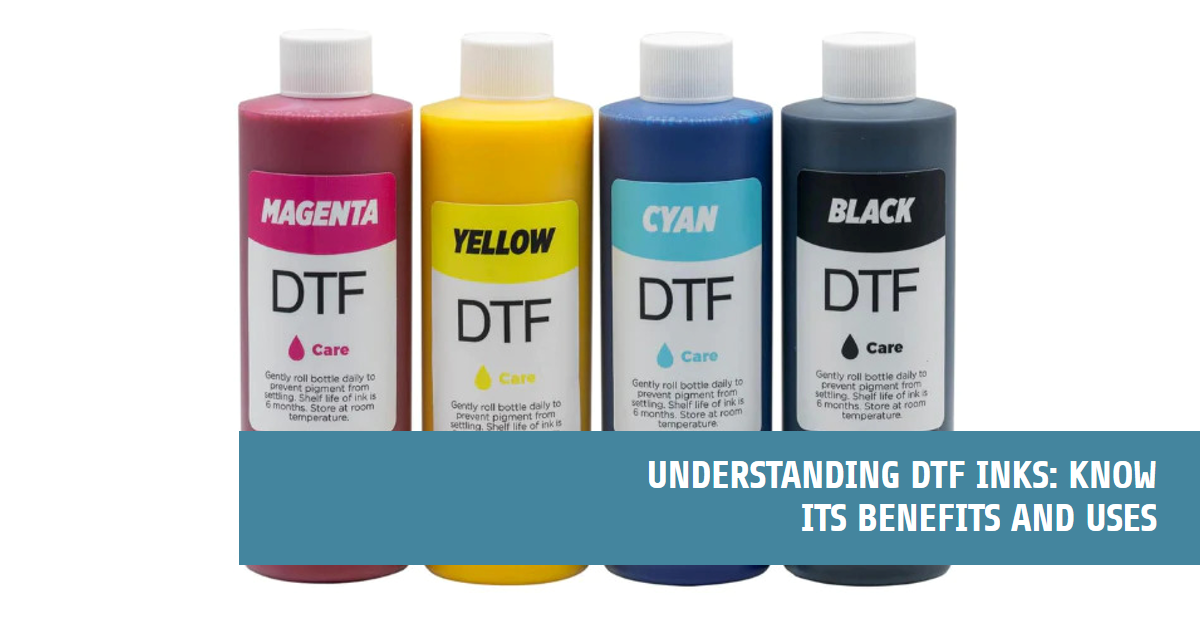What is Dtf Ink?

DTF ink is a type of ink used in direct-to-film printing, which is an alternative printing process. to traditional DTG printing. DTF ink is designed specifically for DTF printing and contains a polymer that helps the ink adhere to the transfer film. DTF ink is made of pigments or dyes, resin, and other additives, and the exact ingredients might change depending on the manufacturer and the composition of the ink. DTF ink is water-based and is formulated to perform the best in specific Epson printheads: DX5, DX7, xp600, 4720, i3200.
What is Dtf Ink Made of?
DTF ink is made of pigments or dyes, resin, and other additives. The exact ingredients of DTF ink may vary depending on the manufacturer and the composition of the ink. DTF ink is designed specifically for DTF printing and contains a polymer that helps the ink adhere to the transfer film. The ink is formulated to perform the best in specific Epson printheads: DX5, DX7, xp600, 4720, i3200.
What are the Benefits of the DTF Inks as Compared to the Other Inks?
DTF ink has several benefits compared to other inks, including:
Versatility: DTF transfers can be printed on any color of materials and a wide variety of material composition. This makes it a great option for printing on a variety of fabrics and substrates.
Durability: DTF transfer prints are much more durable than other methods of printing. They have excellent color accuracy and detail, are durable, and look fantastic.
Low production costs: DTF printing can reduce production time and cost depending on job size. DTF ink is also more affordable compared to DTG printing supplies.
Vibrant colors and designs: DTF ink allows for vibrant colors and designs. The colors from DTF printing have excellent quality and look vivid.
No pretreatment process: With DTF, there is no pretreatment process; you print directly onto film instead of fabric and can print transfers in advance. This helps speed up the printing process.
Special ink and adhesive: DTF printing uses a special ink and adhesive that enhances durability. This makes it ideal for workwear like overalls, high viz, gym, and cycling wear.
What ink do you use for DTF?
DTF printing uses different types of ink depending on the work. Pigment, sublimation, and solvent-based inks are commonly used for DTF printing. DTF ink is used to print to DTF film creating direct to film transfers, and it can be done via the use of a DTG or DTF printer.
What is the Difference Between DTF Ink and Regular ink?
The main differences between DTF ink and regular ink are their composition and purpose. DTF ink is water-based and contains special pigments that are designed to adhere to the surface of the heat transfer film and produce vibrant, long-lasting colors. Regular ink, on the other hand, is not designed for this purpose and may not produce the same quality of results when used for DTF printing.
What is the Cost of Using DTF Inks?
The cost of using DTF printing inks depends on a number of factors, including the type of ink, the quantity you buy, and the supplier you purchase from. However, in general, DTF inks are relatively affordable.
Here is a breakdown of the average costs of DTF inks:
- White ink: $10-15 per liter
- Color inks: $5-10 per liter
- DTF powder: $50-100 per kilogram
- DTF film: $5-10 per sheet
So, for a basic DTF printing setup, you can expect to spend around $50-100 for the inks, powder, and film. This cost will go down as you buy larger quantities of supplies.
Is DTF ink Water-based?
Yes, DTF ink can be water-based. Some DTF inks, such as DTF Heat Transfer Pigment Ink. DTF High-Quality Water-Based Ink is explicitly described as water-based. However, it is important to note that not all DTF inks are water-based, and the ink type can vary depending on the manufacturer and product.
Do you Need Special Ink for DTF Printing?

DTF printing requires specialized ink that is designed to work with the DTF printing process. While regular ink can be used for DTF printing, it is not recommended as it may not provide the same quality and durability as specialized DTF ink. DTF ink is formulated to work with DTF printers and printheads, and it has unique properties that make it suitable for printing on DTF film. DTF ink can be water-based, pigment-based, sublimation-based, or solvent-based depending on the manufacturer and product.
Is Sublimation Ink and DTF Ink the Same?
DTF ink and sublimation ink are not the same, although they share some similarities. Both techniques use heat to transfer the design onto the product, but the way the design is transferred is different. DTF ink uses an adhesive to attach the design to the product, while sublimation ink bonds the ink to the fabric at a molecular level.
As compared to DTF and Sublimation Printing method. Where DTF printers print white ink, which is added behind the full-color image, allowing the colors to show up on dark fabrics. In contrast, sublimation printing is best for photo-realistic designs on light-colored items.
What is the Viscosity of the DTF Ink that Flow Through Printheads?
The viscosity of DTF (Direct to Film) ink that flows through printheads typically ranges from 3.5 to 6 mPa.s at 22°C. This viscosity range is crucial for ensuring smooth ink flow and optimal printing performance. High-quality DTF inks are designed to have low viscosity affected by temperature, which is essential for consistent ink flow and long-term printhead health.
What is the Average Ink Coverage of the DTF Ink?
The average ink coverage of DTF (Direct to Film) ink can vary based on the specific application and the desired level of opacity or coverage.
For Example: However, it is mentioned that a 100% coverage of an A3 size print (approximately 11x17 inches) would consume around 5-7 ml of ink and around 10-12 grams of powder.
What is the Average Shelf Life of the DTF Ink?
The average shelf life of DTF ink can vary depending on several factors, but it generally falls within a range of 12 to 24 months. Here's a breakdown:
Unopened: When stored properly in a cool, dry place away from direct sunlight and extreme temperatures, unopened DTF ink can typically last for 12 to 24 months.
Opened: Once opened, the shelf life of DTF ink can decrease significantly. For CMYK inks, it's usually around 6 months to 1 year at room temperature, while white ink may only last for 3 to 6 months.
How Resistant DTF Inks are from Light Exposure?
The lightfastness of DTF inks varies depending on the specific ink brand and formula, but they generally offer good to excellent resistance to fading from light exposure compared to other printing methods. This means your vibrant designs will stay looking their best for a long time, even with regular exposure to sunlight.
Here's a breakdown of DTF ink's lightfastness:
Pigment-based inks: These are the most lightfast DTF inks, with some brands boasting lightfastness ratings of up to 50 years! The pigments are physically locked within the ink and provide inherent resistance to fading.
Dye-based inks: While not as lightfast as pigment-based inks, dye-based DTF inks still offer decent resistance to fading, typically lasting for several years with proper care. They achieve vibrancy through dissolved dyes within the ink.
Are DTF Inks Resistant to Color Bleeding During Washing?
DTF inks are designed to be resistant to color bleeding during washing. The resistance of the ink to accept dyes on clothes, known as bleed resistance, is determined by the chemical nature of the ink, the degree of ink curing, and the degree of ink deposition. High-quality DTF inks are specifically engineered to prevent color bleeding during washing, ensuring that the prints remain vibrant and durable after repeated wash cycles.
Therefore, DTF inks are formulated to have good bleeding resistance, effectively preventing color shift in the transfer process and maintaining the vibrancy of the prints even after washing.
Are DTF Inks Flexible with Fabric Movement During Cracking?
DTF (Direct to Film) inks are known for their flexibility and resistance to cracking during fabric movement. When properly applied and cared for, DTF prints exhibit excellent resistance to cracking, and the flexibility of DTF prints allows them to move and stretch with the fabric, ensuring durability and integrity during wear and movement.
Additionally, DTF inks are designed to have high flexibility and durability, ensuring that the prints remain vibrant and long-lasting even after repeated washing and wear. Therefore, DTF inks are engineered to be flexible with fabric movement, preventing cracking and ensuring that the prints remain intact and vibrant even after stretching or bending.
Are DTF Inks Designed to Adhere with Different Types of Fabrics?
DTF inks are designed to adhere effectively to a variety of fabrics, including cotton, polyester, and their blends. These inks are formulated to provide exceptional adhesion properties, ensuring that they bond well with different fabric types. The compatibility of DTF inks with various fabrics allows for the development of intricate and vivid designs across a wide range of materials.
Are DTF Inks Eco-friendly and Solvent Free?
DTF inks primarily use water-based pigments instead of harsh solvents, reducing harmful emissions and environmental impact. They are generally considered solvent-free compared to traditional screen printing and some other methods that rely on chemical solvents. This removes the associated health risks and environmental hazards of working with these solvents.
Are DTF Inks Generally Safe?
DTF inks are considered to be safe, depending on the specific formulation used. Water-based DTF inks are considered safer than solvent-based inks, as they use water as a carrier instead of solvents and produce fewer odors. Additionally, some DTF inks are designed to be eco-friendly and solvent-free, making them safer for the environment and people.
Conclusion
DTF transfers are a game-changer for printing custom apparel. DTF ink, made for Direct-to-Film printing, offers several advantages over traditional methods. It works on different fabric colors and types, ensuring versatility. Plus, DTF prints are super durable and look fantastic, giving you long-lasting results. It's cost-effective, saving you time and money, especially on larger orders. DTF ink also brings out vibrant colors and detailed designs. What's great is there's no need for a complicated pretreatment process, making printing faster. So, consider using Custom DTF transfers to create standout, enduring prints on your clothing.

